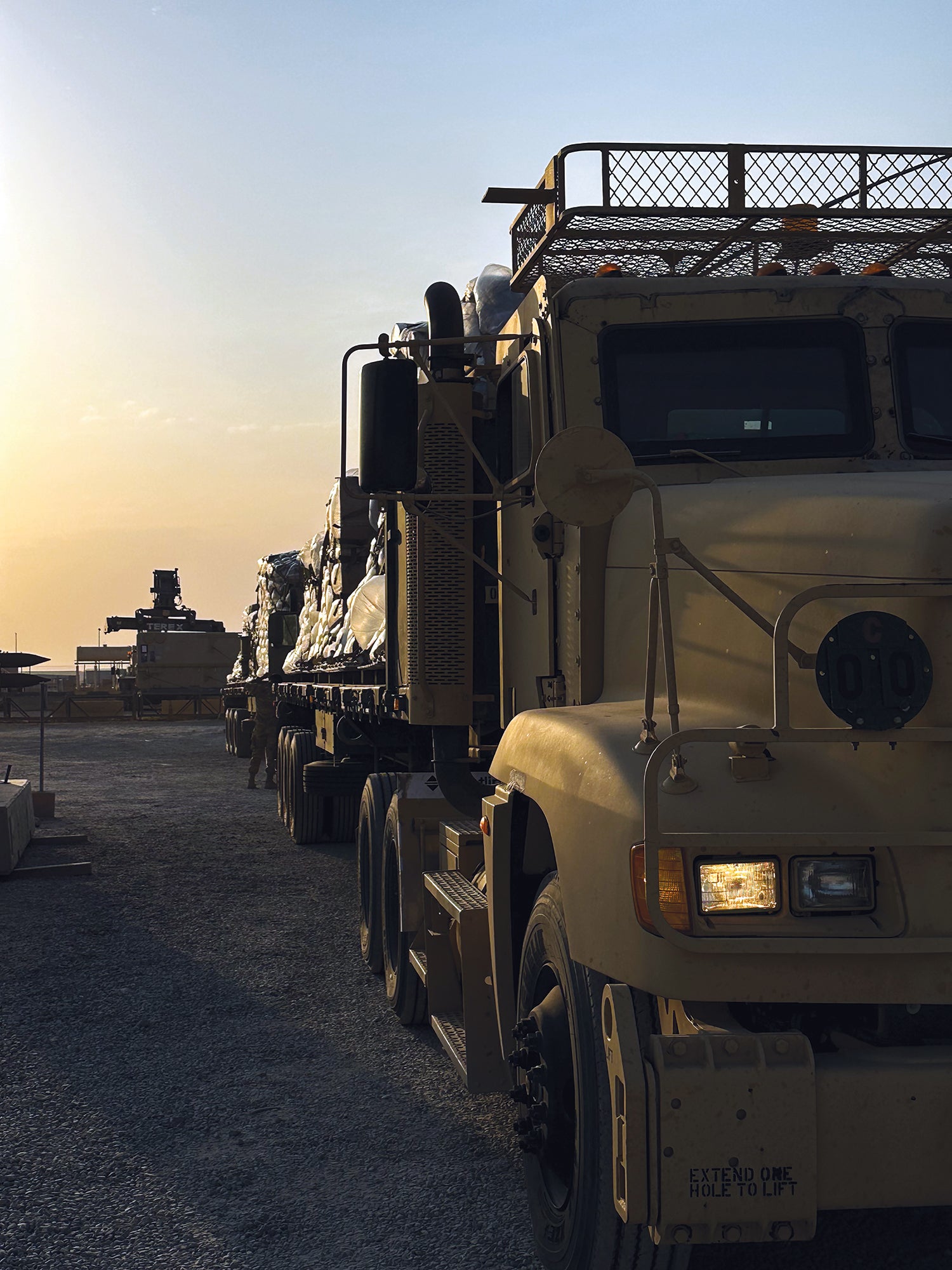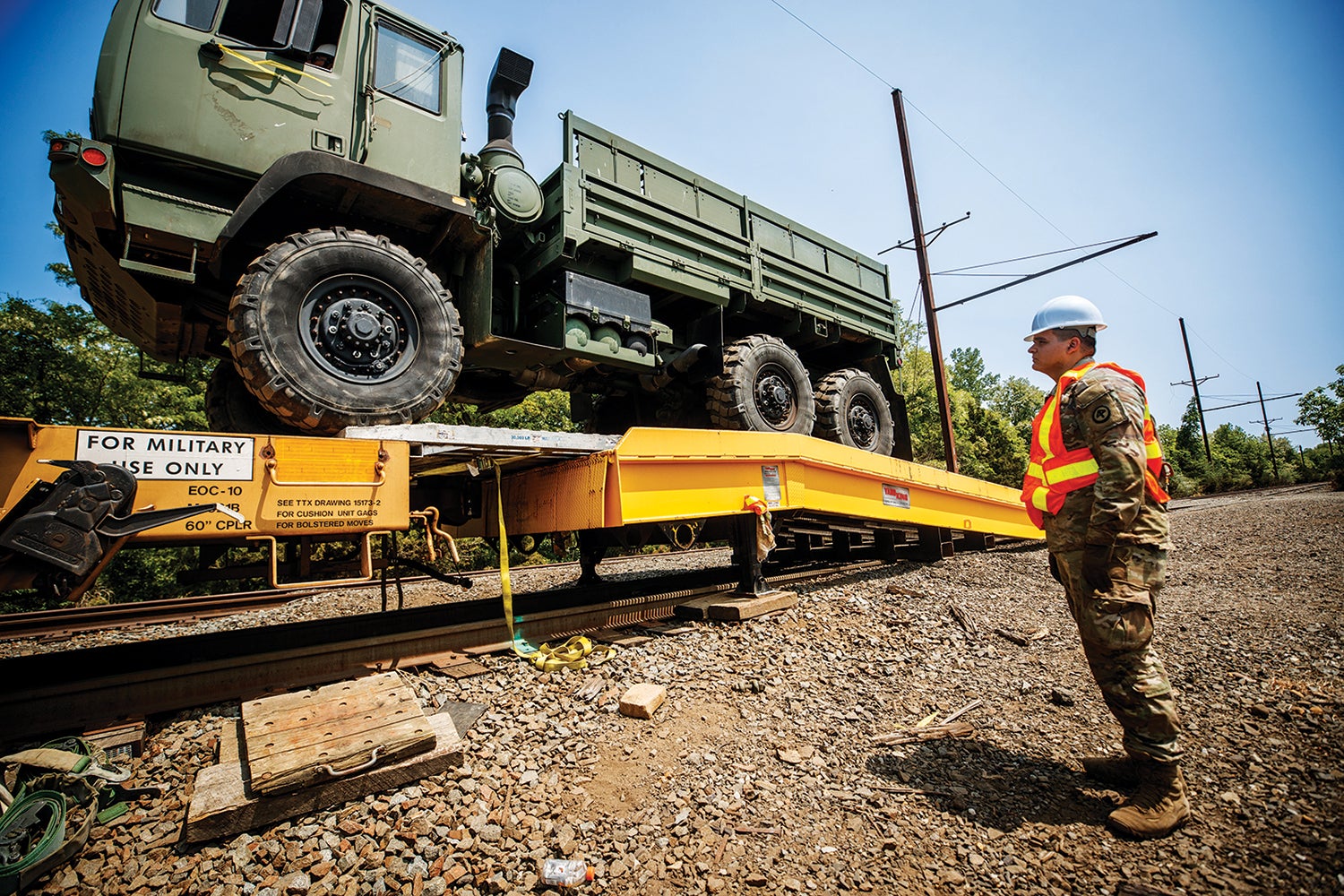The U.S. Army Materiel Command and the U.S. Army sustainment enterprise remain focused on projecting and sustaining combat power, because sustainment is about warfighting, period.
Army Chief of Staff Gen. Randy George made this clear last fall when he assigned Army Materiel Command (AMC) as lead for one of the service’s key focus areas: delivering ready combat formations. His charge, in an October “Message to the Army Team” also signed by Sgt. Maj. of the Army Michael Weimer and Army Secretary Christine Wormuth: “We must be ready to get our formations to the fight and sustain them there.”
To fulfill that commitment, AMC is at the forefront of sustainment modernization efforts to meet the challenges of large-scale combat operations in multidomain environments. The command’s mission is to deliver precision sustainment and materiel readiness to an expeditionary global force from the joint strategic support area to the tactical point of contact. The mission aligns directly with the Army’s focus on delivering ready combat formations.
This requires a strategic mindset of transformation in contact, which is another of the Army’s four key focus areas as outlined in the Message to the Army Team. While this initiative is assigned to the U.S. Army Futures Command, AMC remains closely partnered to designing and sustaining the Army of 2030 and beyond.

Better Capabilities
AMC’s collaboration ensures sustainment modernization efforts align with future requirements. To that end, the sustainment enterprise is nested hand in hand with Futures Command on the Contested Logistics Cross-Functional Team, which addresses the need for more resilient and agile tactical logistics capabilities for the future operating environment.
The Contested Logistics Cross-Functional Team will execute persistent transformation of game-changing technologies to maintain overmatch capabilities of multicapable distribution platforms, advanced power and demand reduction within tactical and operational formations. With a focus on precision and predictive sustainment, the sustainment enterprise and the Contested Logistics Cross-Functional Team will leverage artificial intelligence, machine learning and best-in-class data analytics and visualization tools to increase speed and improve the accuracy of tactical and operational commanders’ decision-making. Through continuous assessment of emerging technologies and their potential applications, AMC ensures that the Army’s ready combat formations are equipped with state-of-the-art capabilities, enhancing their lethality and effectiveness.
The Contested Logistics Cross-Functional Team also will be pivotal to sustaining the joint force and will seek opportunities to partner with the other services, academia and industry to modernize the Army and joint formations across all domains, as well as increase interoperability with coalition partners.

At the Speed of War
An integral part of delivering ready combat formations is posturing the joint strategic support area. This effort encompasses mobilization and deployment as AMC fortifies installations capable of supporting current and evolving readiness and power projection requirements at the speed of war in a contested environment. The Army’s ability to rapidly and effectively mobilize, deploy and sustain combat-credible land forces worldwide is a critical component to strategic readiness and a competitive advantage over adversaries.
The Army’s Organic Industrial Base also must be capable of sustaining fielded systems, maintaining pace with Army modernization efforts and remaining postured to surge in support of large-scale combat operations. Through a 15-year Organic Industrial Base Modernization Implementation Plan, AMC is modernizing facilities, processes and the workforce across Army depots, arsenals and ammunition plants. This effort will identify and mitigate supply chain risks, reduce single points of failure and reliance on foreign sources and better meet current, surge and future requirements.
The war in Ukraine has demonstrated the criticality of a responsive defense industrial base, and AMC works closely with industry partners to align our Organic Industrial Base efforts with theirs to assure a robust, resilient and dynamic industrial base ecosystem that can provide required capabilities at the speed and scale necessary for near-peer conflict.

Taking Stock
AMC also must maintain the serviceability of its on-hand equipment through the command’s enduring equipment sustainment program by maximizing lateral transfers, depot issues and component redistribution to ensure equipment is not exceeding its preferred life cycle. In contrast, AMC must divest equipment that is no longer serviceable.
Part of the command’s action plan is to rapidly redistribute excess materiel and divest obsolete equipment. AMC is leading an Armywide effort to identify excess and obsolete equipment across the force and determine the most efficient and cost-effective way to rapidly remove it from the Army’s property books and unburden company commanders. In fiscal 2023, units turned in more than 75,000 pieces of equipment to one of the 14 Modernization Displacement and Repair Sites managed by the U.S. Army Sustainment Command, reducing excess or obsolete equipment and freeing space for modernized equipment.
Even as AMC postures the joint strategic support area, Materiel Command soldiers are equally focused on preparing theaters and the operational area to meet Army and joint force requirements. Army pre-positioned stocks—sets of equipment that are modernized, right-sized and strategically located to effectively serve as a strategic deterrent in integrated campaigning, competition and conflict—are key to this effort.

To do this right, AMC soldiers must inject discipline into the distribution process and determine resource priority to ensure that stocks are optimally postured and equipped to meet joint force requirements. Proper alignment and distribution allow AMC to deliver ready combat formations by enhancing strategic mobility, increasing force projection velocity and enabling the Army to rapidly build combat power to support national objectives.
To that end, AMC will host a joint sustainment seminar this summer to address sustainment requirements in a contested environment to better inform challenges and opportunities across the joint force and industrial base.
Sustainers also must consider reorganization and reconstitution during a large-scale fight where the scale and destructive nature of the battlefield potentially will result in greater loss of weapon systems, supplies and equipment at unprecedented speed. While resource-intensive, reconstitution may return ready combat formations to the fight faster and better equipped.


Harnessing Information
As AMC transforms the sustainment warfighting function, it bears repeating: Sustainment is about warfighting, period. Future sustainment operations must focus on predictive logistics capabilities and align with warfighting functions to support requirements across the breadth of the battle space—from the foxhole to the joint strategic support area—to ensure freedom of action, extended operational reach and prolonged endurance. The Army is preparing to sustain large-scale combat operations within a contested logistics environment using predictive logistics to inform and sustain resupply capabilities on the front lines.
AMC is advancing collection, storage, accessibility, analysis and communication of large streams of data across echelons to inform future decisions. The command also is standardizing and specializing its supply chain management, using data to drive decision-making with predictive analytics to better adapt to supply chain disruptions and reduce vulnerabilities in support of joint force readiness. As one launching point, our innovative AMC predictive analysis suite provides real-time data to execute global end-to-end surface deployment and distribution services.


Driving Force
In the end, however, it all comes full circle to the Army’s most important asset—its people. As noted in the Message to the Army Team when defining the service’s four focus areas: “At the heart of our Army’s readiness is people.”
Increased quality of life for soldiers, Army civilians and families is directly tied to increased Army readiness and critical to delivering ready combat formations. Just as the Army sustainment enterprise is focused on continuous transformation and modernization of sustainment capabilities, so, too, the Army is focused on improving the quality and consistency of programs and services that soldiers and families rely on most.
To better educate and inform AMC soldiers about available services and programs, and provide reliable and timely information at their fingertips, the command is prototyping an upgraded, more user-friendly installation app. Command leadership will meet soldiers where they are to provide information they need and want. From housing to child care, food services to the permanent change-of-station process, there is no end state to the command’s quality-of-life efforts. The Army will continue its work to ensure that it is an employer of choice for soldiers, Army civilians and families.
Delivering ready combat formations for the Army and joint force is no small task, but the Army sustainment enterprise is up for the challenge. AMC has the best Army sustainers and logisticians focused on supporting the world’s best-led, best-trained and best-equipped fighting force. AMC will remain ready to get Army formations to the fight and sustain them there—anytime, anyplace.


* * *
Gen. Charles Hamilton became the 21st commanding general of the U.S. Army Materiel Command, Redstone Arsenal, Alabama, in March 2023. Previously, he was the Army’s deputy chief of staff for logistics. He deployed to and held commands three times in Afghanistan. He was commissioned in 1988 as the Distinguished Military Graduate of his Officer Candidate School class. He has two master’s degrees: one in public administration from Central Michigan University and one in military studies from Marine Corps University.

